Electric Buses in Malaysia: Policies, Innovations, Technologies and Life Cycle Evaluations
Abstract
:1. Introduction
2. Malaysia Roadmap by 2014 and 2020: Goals and Policies
2.1. NAP 2014
2.2. NAP 2020
- 1.
- Stimulate application and manufacturing of local battery packs batteries together with enhancement of BMS.
- 2.
- Establish standards to promote wireless charging and battery swapping.
- 3.
- Establish standards for disposal and recycling of batteries.
- 4.
- Develop practicability research on hydrogen fuel cell technology.
- 5.
- Build EB smart grid interoperability centers.
- 6.
- Employ well-to-wheel model in the computation of emission from EB.
2.3. Compared Kuala Lumpur Roadmaps with Other Cities
- A.
- Addis Ababa had introduced the first two trolley EBs that were assembled locally by supporting a Russian company. However, the Ethiopian Government has not had any initiative in planning about adopting EBs.
- B.
- Ahmedabad is in a move to adopt EBs, where eight EBs were dedicated to the city.
- C.
- Although the manufacturer conducted an EB pilot test in Quito, the Government has not had any meaningful discussions about adopting EB or made any plans in this area.
- D.
- In Mexico City, the Government is conducting a long-term policy and is scheduling to adopt EB pilots on specific routes once the analysis and research have been completed.
- E.
- Cape Town developed a structured pilot plan after conducting a small fleet of EBs (not yet operational). When the case study was conducted, however, the initiative was under investigation by local authorities.
- F.
- Bangalore has a three-month EB trial administered by a manufacturing company, but the decision-makers did not further develop the project or purchase EB. Thus, the EB adoption project in Bangalore cannot be considered the trial phase as a structured pilot.
- G.
- The pilot project for adopting EB in Belo Horizonte was started in 2016, but the project has not been formally implemented at the time of reporting.
- H.
- IADB pilot project for EB adoption in Bogotá was launched in previous years, but the project was not formally implemented at the time of reporting.
- I.
- In the race to deploy and test EBs, Singapore has emerged as the frontrunner by captivating multiple substantial initiatives in recent years. Singapore city has published the guidelines and standards for autonomous vehicles (AVs), but it is on track for planned pilot deployment in 2022.
- J.
- There have been various EBs pilot projects in Putrajaya conducted by multiple manufacturing companies, such as Putra NEDO EB Project associated with the charging system of super quick charge (SQC).
- K.
- Nowadays, there are 15 BYD K9UB BEs as a part of the EMT Madrid fleet operation. Additionally, EMT Madrid has approved a 35 million Euro investment for the purchase of 50 new EBs.
- L.
- The 25 EBs in Philadelphia were deployed in 2019, which California-based automaker Proterra built. This project is supported by the federal low or no emission vehicle program and Pennsylvania Act 89.
- M.
- A total of 25 EBs have been assigned to the Manali fleet. The EBs, on the other hand, only run for a limited period each year, and they plan to scale up the project is unclear.
- N.
- In late 2018, Santiago integrated 100 EBs, followed by another 100 in early 2019. However, it is unclear whether these new buses qualify as “bulk route operations”.
- O.
- Shenzhen is the world’s first major city to run an entirely EB fleet (around 16,000 EBs).
3. EB Innovations in Malaysia
3.1. Sync R&D EB Prototype
3.2. Malaysian Automotive Institute (MAI) EB Prototype
3.3. Go Auto-Higer EB Prototype
4. Electric Bus Technologies in Malaysia
4.1. EB Technology in Putrajaya
4.2. EB Technology in Sarawak
4.3. EB Technology in Melaka
5. Life Cycle: Generic Framework
5.1. Model Inputs
5.2. Process Model
5.2.1. Demand Model
- Aerodynamic Drag force ()
- Rolling Resistance Force (
- Grade Force
- Transient Force
- Driving Force ()
5.2.2. Life Cycle Model
- Capital Costs
- Operational Costs
- Labor Costs
- Social Costs of Carbon (CCS)
5.3. Model Outputs
6. Discussion
7. Limitations and Future Works
8. Conclusion and Policy Implications
8.1. Policy Implications and Suggestions
8.2. Conclusions
Author Contributions
Funding
Institutional Review Board Statement
Informed Consent Statement
Data Availability Statement
Conflicts of Interest
References
- IEA. Global Energy Review. 2020. Available online: https://www.iea.org/reports/global-energy-review-2020/renewables (accessed on 13 September 2020).
- Van Velzen, A.; Annema, J.A.; van de Kaa, G.; van Wee, B. Proposing a more comprehensive future total cost of ownership estimation framework for electric vehicles. Energy Policy 2019, 129, 1034–1046. [Google Scholar] [CrossRef]
- Shahid, S.; Minhans, A.; Puan, O.C. Assessment of Greenhouse Gas Emission Reduction Measures in Transportation Sector of Malaysia. J. Teknol. 2014, 70, 1–8. [Google Scholar] [CrossRef] [Green Version]
- Ghosh, A. Possibilities and Challenges for the Inclusion of the Electric Vehicle (EV) to Reduce the Carbon Footprint in the Transport Sector: A Review. Energies 2020, 13, 2602. [Google Scholar] [CrossRef]
- Hannan, M.; Al-Shetwi, A.Q.; Begum, R.; Ker, P.J.; Rahman, S.; Mansor, M.; Mia, M.; Muttaqi, K.; Dong, Z. Impact assessment of battery energy storage systems towards achieving sustainable development goals. J. Energy Storage 2021, 42, 103040. [Google Scholar] [CrossRef]
- Połom, M.; Wiśniewski, P. Assessment of the Emission of Pollutants from Public Transport Based on the Example of Diesel Buses and Trolleybuses in Gdynia and Sopot. Int. J. Environ. Res. Public Health 2021, 18, 8379. [Google Scholar] [CrossRef] [PubMed]
- Połom, M.; Wiśniewski, P. Implementing Electromobility in Public Transport in Poland in 1990–2020. A Review of Experiences and Evaluation of the Current Development Directions. Sustainability 2021, 13, 4009. [Google Scholar] [CrossRef]
- Połom, M. E-revolution in post-communist country? A critical review of electric public transport development in Poland. Energy Res. Soc. Sci. 2021, 80, 102227. [Google Scholar] [CrossRef]
- Kim, H.; Hartmann, N.; Zeller, M.; Luise, R.; Soylu, T. Comparative TCO Analysis of Battery Electric and Hydrogen Fuel Cell Buses for Public Transport System in Small to Midsize Cities. Energies 2021, 14, 4384. [Google Scholar] [CrossRef]
- Muratori, M. Impact of uncoordinated plug-in electric vehicle charging on residential power demand. Nat. Energy 2018, 3, 193–201. [Google Scholar] [CrossRef]
- Teoh, L.E.; Khoo, H.L.; Goh, S.Y.; Chong, L.M. Scenario-based electric bus operation: A case study of Putrajaya, Malaysia. Int. J. Transp. Sci. Technol. 2018, 7, 10–25. [Google Scholar] [CrossRef]
- Elgowainy, A.; Rousseau, A.; Wang, M.; Ruth, M.; Andress, D.; Ward, J.; Joseck, F.; Nguyen, T.; Das, S. Cost of ownership and well-to-wheels carbon emissions/oil use of alternative fuels and advanced light-duty vehicle technologies. Energy Sustain. Dev. 2013, 17, 626–641. [Google Scholar] [CrossRef]
- Jwa, K.; Lim, O. Comparative life cycle assessment of lithium-ion battery electric bus and Diesel bus from well to wheel. Energy Procedia 2018, 145, 223–227. [Google Scholar] [CrossRef]
- Bhattacharjee, A.; Mohanty, R.; Ghosh, A. Design of an Optimized Thermal Management System for Li-ion Batteries under Different Discharging Conditions. Energies 2020, 13, 5695. [Google Scholar] [CrossRef]
- Wang, J.; Kang, L.; Liu, Y. Optimal scheduling for electric bus fleets based on dynamic programming approach by considering battery capacity fade. Renew. Sustain. Energy Rev. 2020, 130, 109978. [Google Scholar] [CrossRef]
- Global Electric Bus Adoption. Global Electric Bus Adoption to Triple by 2025. 2019. Available online: https://www.greentechmedia.com/articles/read/global-electric-bus-adoption-is-set-to-triple-by-2025 (accessed on 6 August 2021).
- Mahmoud, M.; Garnett, R.; Ferguson, M.; Kanaroglou, P. Electric buses: A review of alternative powertrains. Renew. Sustain. Energy Rev. 2016, 62, 673–684. [Google Scholar] [CrossRef]
- Bayindir, K.; Çağatay; Gözüküçük, M.A.; Teke, A. A comprehensive overview of hybrid electric vehicle: Powertrain configurations, powertrain control techniques and electronic control units. Energy Convers. Manag. 2011, 52, 1305–1313. [Google Scholar] [CrossRef]
- Ribau, J.; Silva, C.; Sousa, J.M.C. Efficiency, cost and life cycle CO2 optimization of fuel cell hybrid and plug-in hybrid urban buses. Appl. Energy 2014, 129, 320–335. [Google Scholar] [CrossRef]
- Yong, J.Y.; Ramachandaramurthy, V.K.; Tan, K.M.; Mithulananthan, N. A review on the state-of-the-art technologies of electric vehicle, its impacts and prospects. Renew. Sustain. Energy Rev. 2015, 49, 365–385. [Google Scholar] [CrossRef]
- Chan, C.C. The State of the Art of Electric, Hybrid, and Fuel Cell Vehicles. Proc. IEEE 2007, 95, 704–718. [Google Scholar] [CrossRef]
- Offer, G.; Howey, D.; Contestabile, M.; Clague, R.; Brandon, N. Comparative analysis of battery electric, hydrogen fuel cell and hybrid vehicles in a future sustainable road transport system. Energy Policy 2010, 38, 24–29. [Google Scholar] [CrossRef] [Green Version]
- Poullikkas, A. Sustainable options for electric vehicle technologies. Renew. Sustain. Energy Rev. 2015, 41, 1277–1287. [Google Scholar] [CrossRef]
- Al-Ogaili, A.S.; Ramasamy, A.; Hashim, T.J.T.; Al-Masri, A.N.; Hoon, Y.; Jebur, M.N.; Verayiah, R.; Marsadek, M. Estimation of the energy consumption of battery driven electric buses by integrating digital elevation and longitudinal dynamic models: Malaysia as a case study. Appl. Energy 2020, 280, 115873. [Google Scholar] [CrossRef]
- Kuys, J.-O., (Jo); Melles, G.; Thompson-Whiteside, S.; Kapoor, A. Scoping the Human-Centred Design Led 2020 Vision for Malaysia Electric Buses (EV). SAE Tech. Pap. Ser. 2015, 1, 01-0031. [Google Scholar] [CrossRef]
- Rahman, A.; Mohiuddin, A.; Ismail, A.F. Prospects and challenges of electric vehicle adaptability: An energy review Malaysia. Energy Educ. Sci. Technol. 2018, 36, 139–151. [Google Scholar]
- Jawi, Z.M.; Lamin, F.; Manap, A.R.A.; Abas, F.; Voon, W.S. Review of the National Automotive Policy on Car Maintenance Issues: Malaysia’s Automotive Ecosystem Explained. 1–60, Unpublished.
- National Automotive Policy. NAP 2014 Roadmap–Highlights of the Action Plan. 2014. Available online: https://paultan.org/2014/02/07/nap-2014-roadmap-highlights-detailed/ (accessed on 6 June 2021).
- Rosli, M.; Kari, F. Malaysia’s National Automotive Policy and the Performance of Proton’s Foreign and Local Vendors. Asia Pac. Bus. Rev. 2008, 14, 103–118. [Google Scholar] [CrossRef]
- World Resources Institute. Barriers to Adopting Electric Buses, Transportation Research Board. 2019. Available online: https://www.wri.org/publication/barriers-adopting-electric-buses (accessed on 10 June 2019).
- Alkatiri, W. Re-imagining Simple Living and Uncertainty: Transition to Carbon-neutral Economy in Developing Countries. Int. J. Asian Philos. Assoc. 2021, 7, 1–8. [Google Scholar]
- Ramachandran, Ramakrishnan, CSR and Sustainable Development—A Primer. Available online: https://ssrn.com/abstract=3904878 (accessed on 11 November 2020).
- Nundy, S.; Ghosh, A.; Mesloub, A.; Albaqawy, G.A.; Alnaim, M.M. Impact of COVID-19 pandemic on socio-economic, energy-environment and transport sector globally and sustainable development goal (SDG). J. Clean. Prod. 2021, 312, 127705. [Google Scholar] [CrossRef]
- Ghosh, A.; Nundy, S.; Mallick, T.K. How India is dealing with COVID-19 pandemic. Sensors Int. 2020, 1, 100021. [Google Scholar] [CrossRef]
- Ratnasingam, J.; Khoo, A.; Jegathesan, N.; Wei, L.C.; AbdLatib, H.; Thanasegaran, G.; Liat, L.C.; Yi, L.Y.; Othman, K.; Amir, M.A. How are small and medium enterprises in Malaysia’s furniture industry coping with COVID-19 pandemic? Early evidences from a survey and recommendations for policymakers. BioResources 2020, 15, 5951–5964. [Google Scholar]
- EBIM. Elektrik Bas Inovasi Malaysia (EBIM) Program. Available online: http://ebim.my/ebim/ (accessed on 1 July 2021).
- Chandran, V.; Patil, C.; Karthick, A.; Ganeshaperumal, D.; Rahim, R.; Ghosh, A. State of Charge Estimation of Lithium-Ion Battery for Electric Vehicles Using Machine Learning Algorithms. World Electr. Veh. J. 2021, 12, 38. [Google Scholar] [CrossRef]
- Zoltowska, I.; Lin, J. Optimal Charging Schedule Planning for Electric Buses Using Aggregated Day-Ahead Auction Bids. Energies 2021, 14, 4727. [Google Scholar] [CrossRef]
- Lye, G. MAI Previews Malaysian-Funded E-Bus Prototype. 2015. Available online: https://paultan.org/2015/11/16/mai-previews-malaysian-funded-e-bus-prototype/ (accessed on 22 May 2021).
- Motoring-Malaysia. Buses: The Go Auto—Higer Electric Bus Spotted at Go Auto HQ in Glenmarie. Available online: https://motoring-malaysia.blogspot.com/2018/08/buses-go-auto-higer-electric-bus.html (accessed on 21 June 2019).
- Siemens. Electrification of Bus and Truck: An Easy Task with the Proven ELFA System. Available online: https://new.siemens.com/global/en/markets/transportation-logistics/electromobility/drive-systems-for-commercial-vehicles.html/ (accessed on 23 April 2018).
- Global Mass Transit Report. Malaysia Launches Putra-NEDO EV Bus Project. Available online: https://www.globalmasstransit.net/archive.php?id=27477 (accessed on 2 February 2017).
- Md Hanafiah, F.; Azmi, M.A.A.; Ibrahim, S.H.; Md Zan, Z. The effect of sustainable development on environmental agenda. Case study: Putrajaya Green City, Malaysia. Proceedings of The International Seminar on Regional Politics, Administration and Development 2020 (INSORPAD2020), Riau, Indonesia, 15 October 2020; 2020; pp. 728–736. [Google Scholar]
- Azmi, M.A.A. The Effect of Sustainable Development on Environmental Agenda. Case Study: Putrajaya Green City, Malaysia. Ph.D. Thesis, University Utara Malaysia, Sintok, Malaysia, 2015. [Google Scholar]
- SarawakTransport, Electric Bus Marks New Milestone in Sarawak Transport History. Available online: https://dayakdaily.com/electric-bus-marks-new-milestone-in-sarawak-transportation-history/ (accessed on 1 March 2019).
- Guschinsky, N.; Kovalyov, M.Y.; Rozin, B.; Brauner, N. Fleet and charging infrastructure decisions for fast-charging city electric bus service. Comput. Oper. Res. 2021, 135, 105449. [Google Scholar] [CrossRef]
- Ding, X.; Zhang, W.; Wei, S.; Wang, Z. Optimization of an Energy Storage System for Electric Bus Fast-Charging Station. Energies 2021, 14, 4143. [Google Scholar] [CrossRef]
- Yıldırım, S.; Yıldız, B. Electric bus fleet composition and scheduling. Transp. Res. Part C Emerg. Technol. 2021, 129, 103197. [Google Scholar] [CrossRef]
- Bus Interchange. BYD K9 Trial—Melaka—Bus Report. 2018. Available online: https://businterchange.net/busphoto/album.php?album=119 (accessed on 29 December 2020).
- Song, Z.; Liu, Y.; Gao, H.; Li, S. The Underlying Reasons behind the Development of Public Electric Buses in China: The Beijing Case. Sustainability 2020, 12, 688. [Google Scholar] [CrossRef] [Green Version]
- Comello, S.; Glenk, G.; Reichelstein, S. Transitioning to clean energy transportation services: Life-cycle cost analysis for vehicle fleets. Appl. Energy 2021, 285, 116408. [Google Scholar] [CrossRef]
- Harris, A.; Soban, D.; Smyth, B.M.; Best, R. Assessing life cycle impacts and the risk and uncertainty of alternative bus technologies. Renew. Sustain. Energy Rev. 2018, 97, 569–579. [Google Scholar] [CrossRef] [Green Version]
- Borén, S. Electric buses’ sustainability effects, noise, energy use, and costs. Int. J. Sustain. Transp. 2020, 14, 1–16. [Google Scholar] [CrossRef] [Green Version]
- Abdullah, W.S.W.; Osman, M.; Ab Kadir, M.Z.A.; Verayiah, R. The Potential and Status of Renewable Energy Development in Malaysia. Energies 2019, 12, 2437. [Google Scholar] [CrossRef] [Green Version]
- Krolikowski, P.M.; Naggert, K.N. Semiconductor Shortages and Vehicle Production and Prices. Econ. Comment. (Federal Reserv. Bank Cleveland) 2021, 1–6. [Google Scholar] [CrossRef]
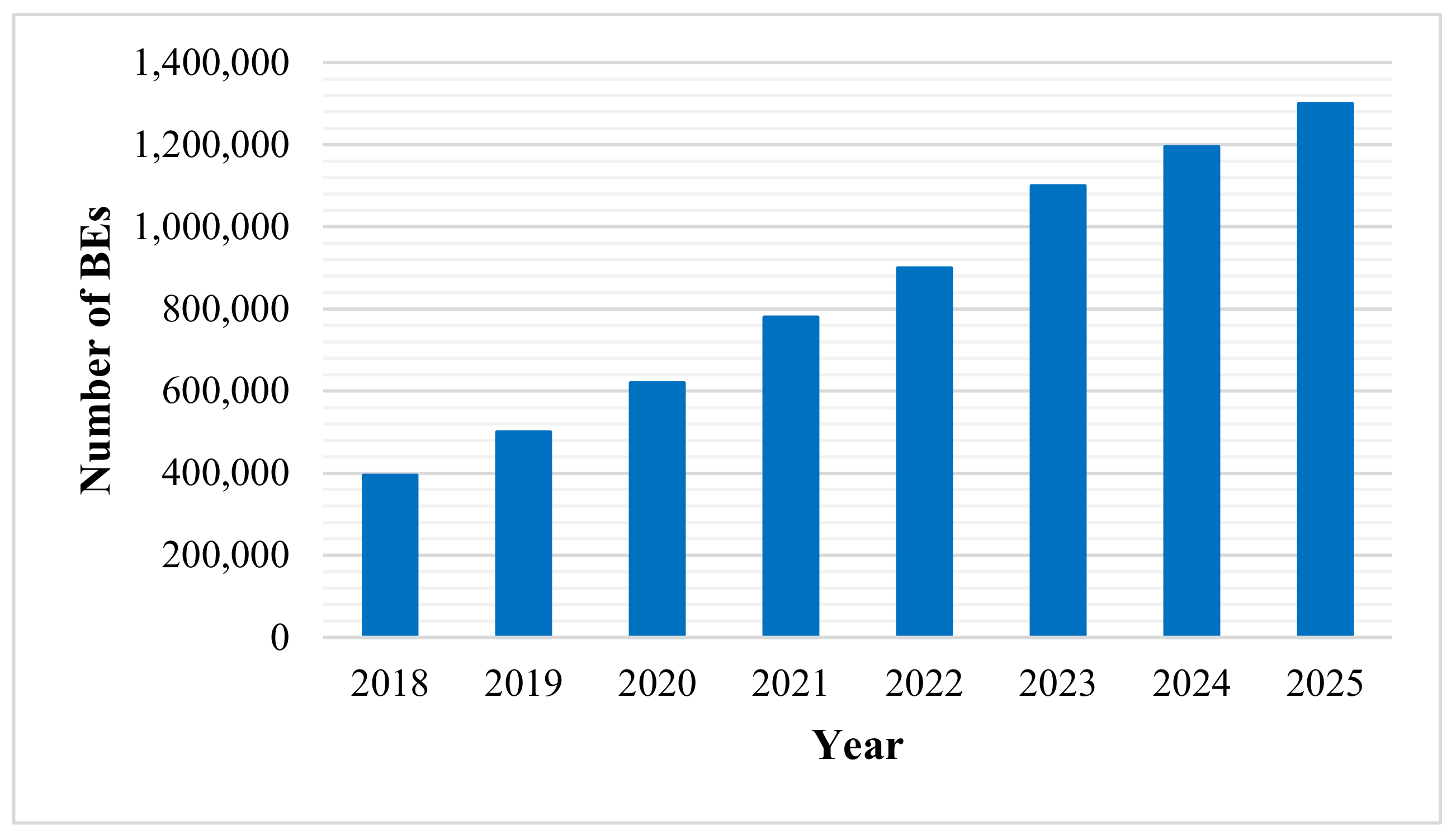
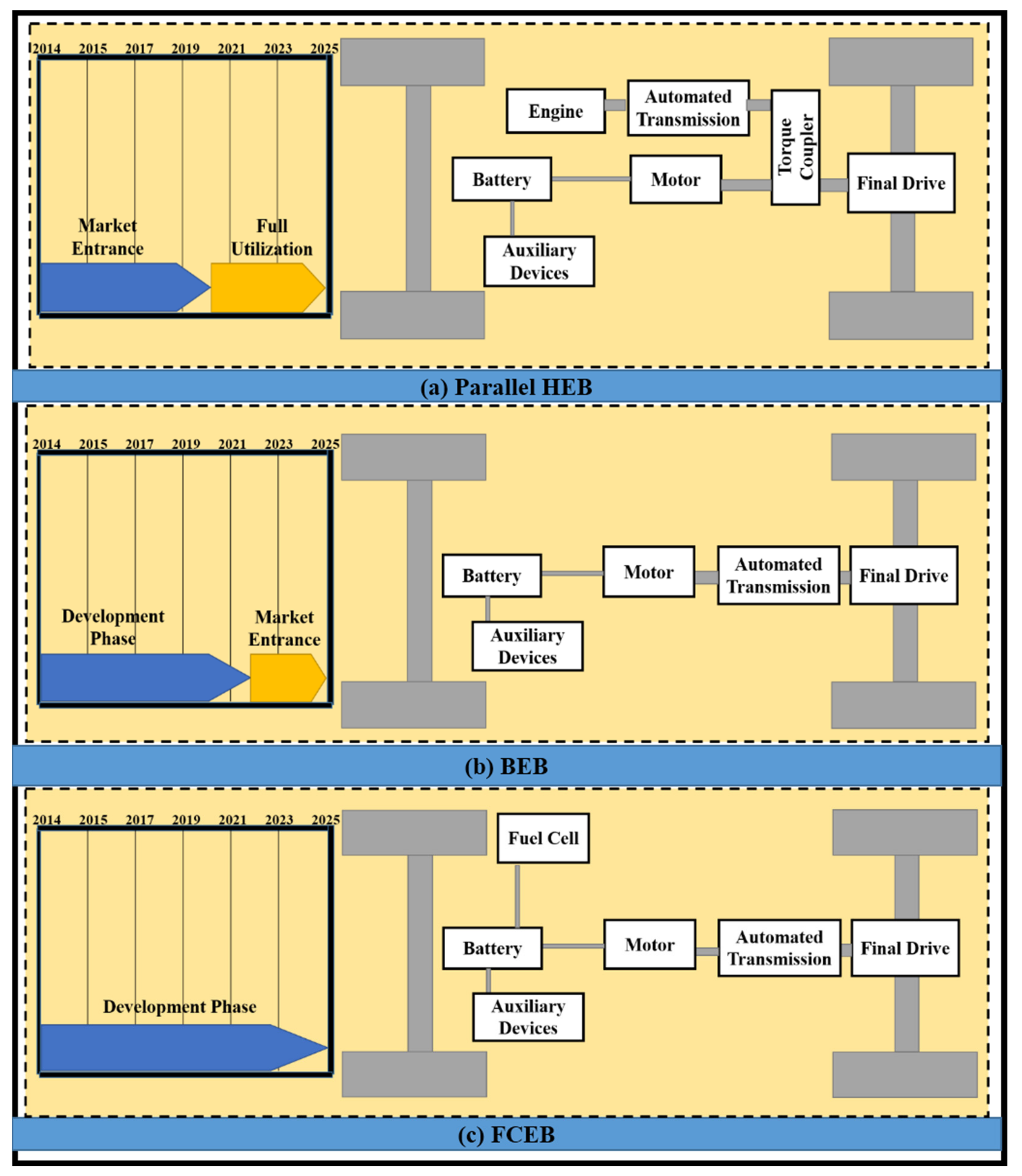
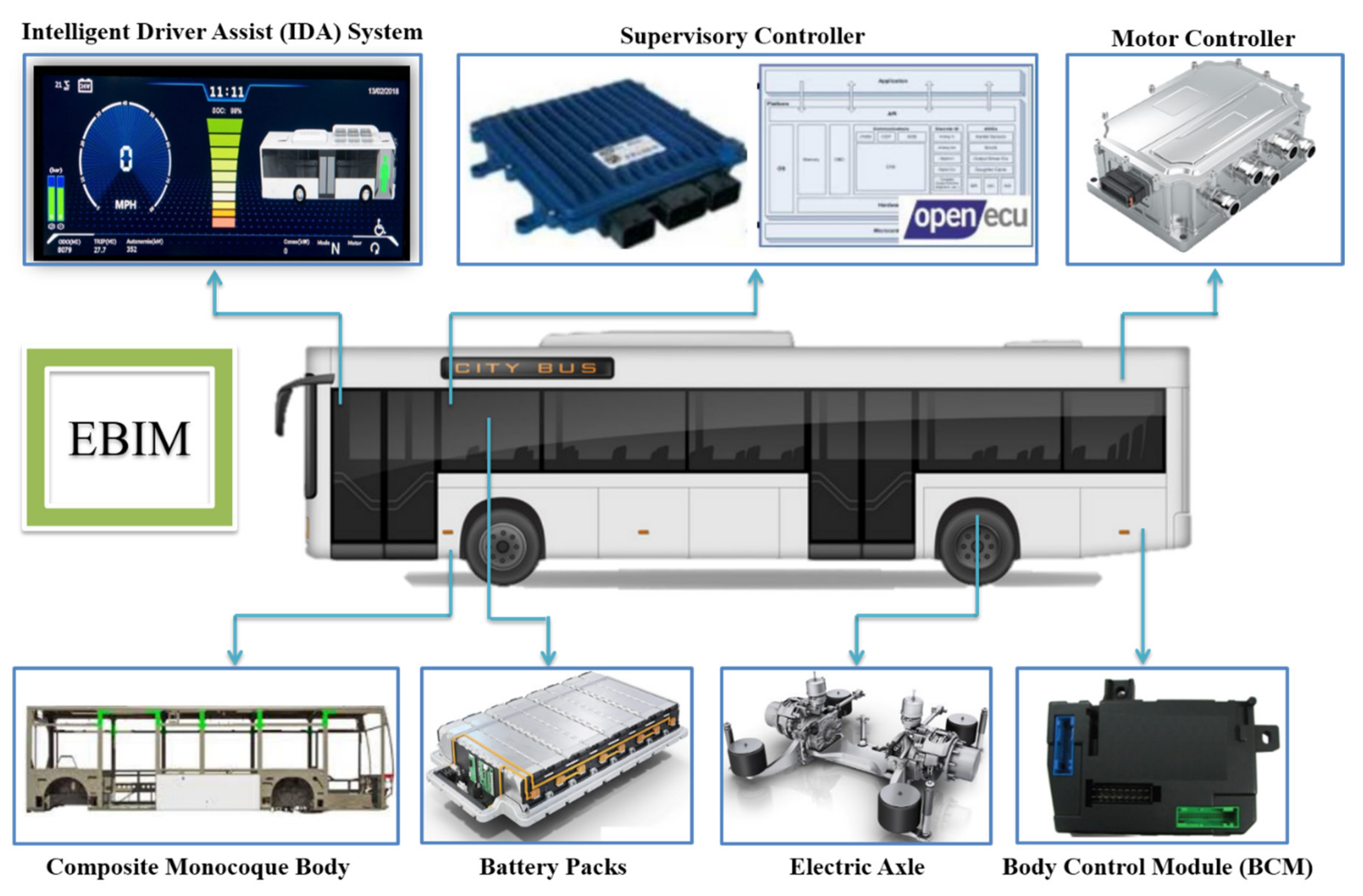
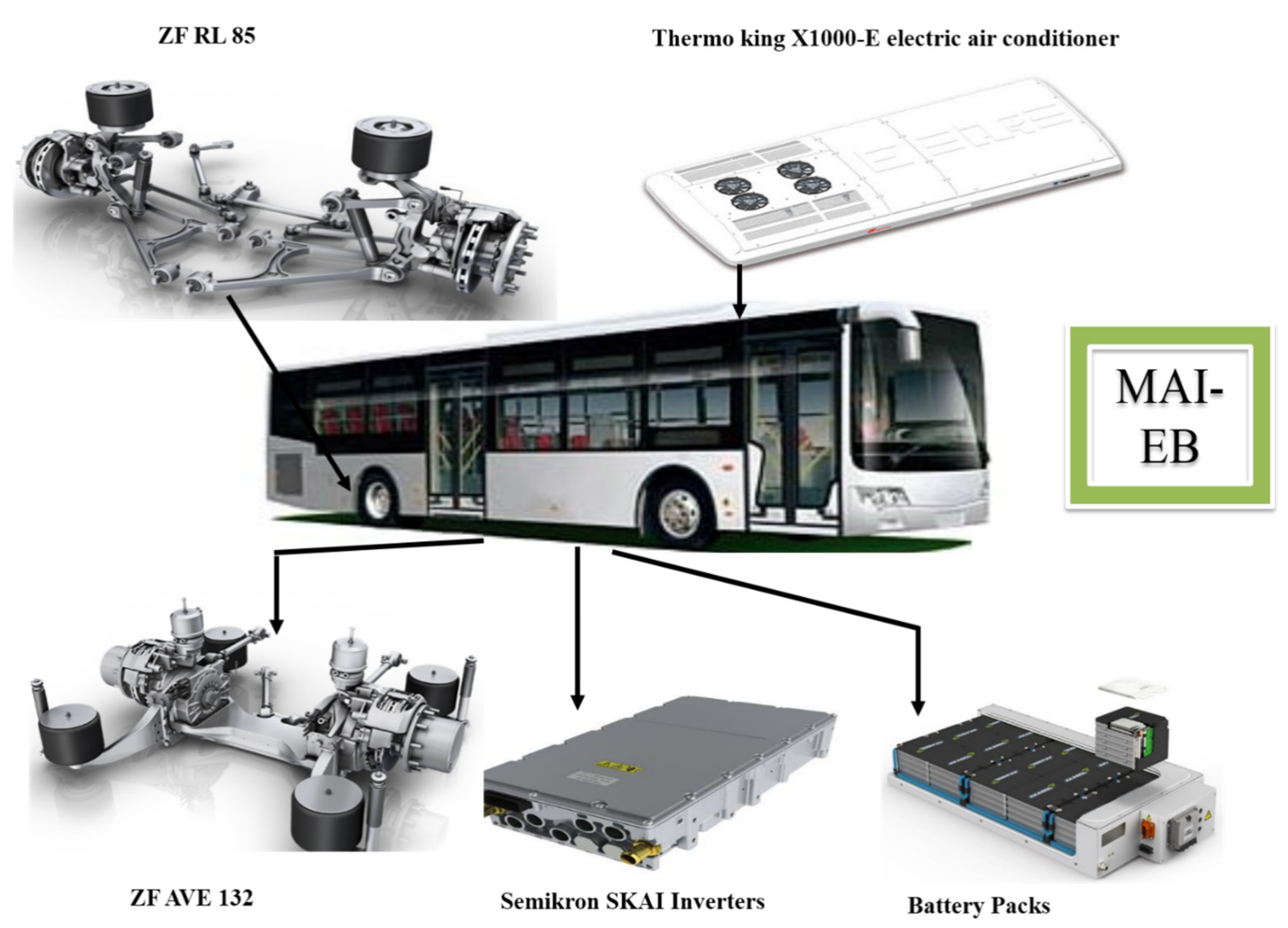
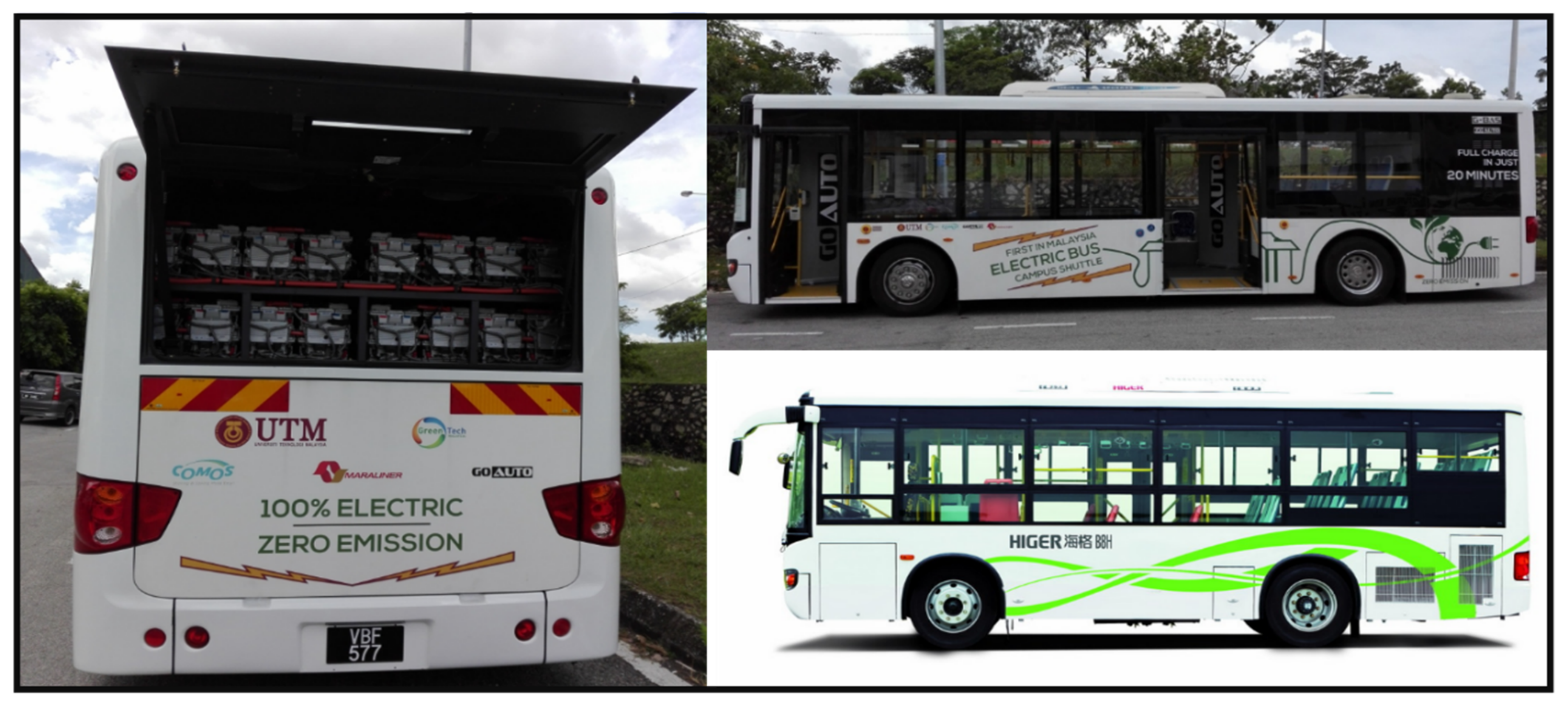
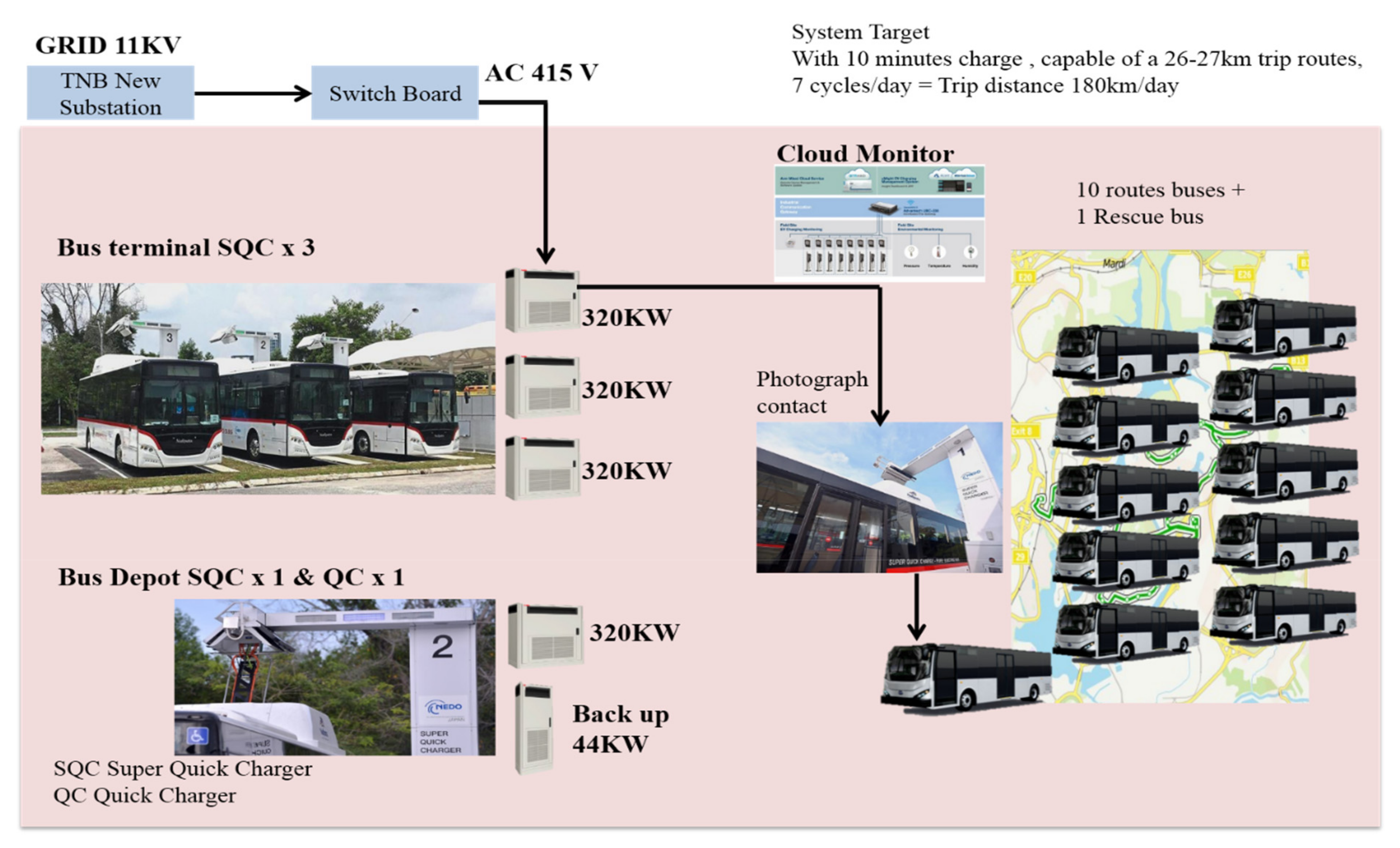
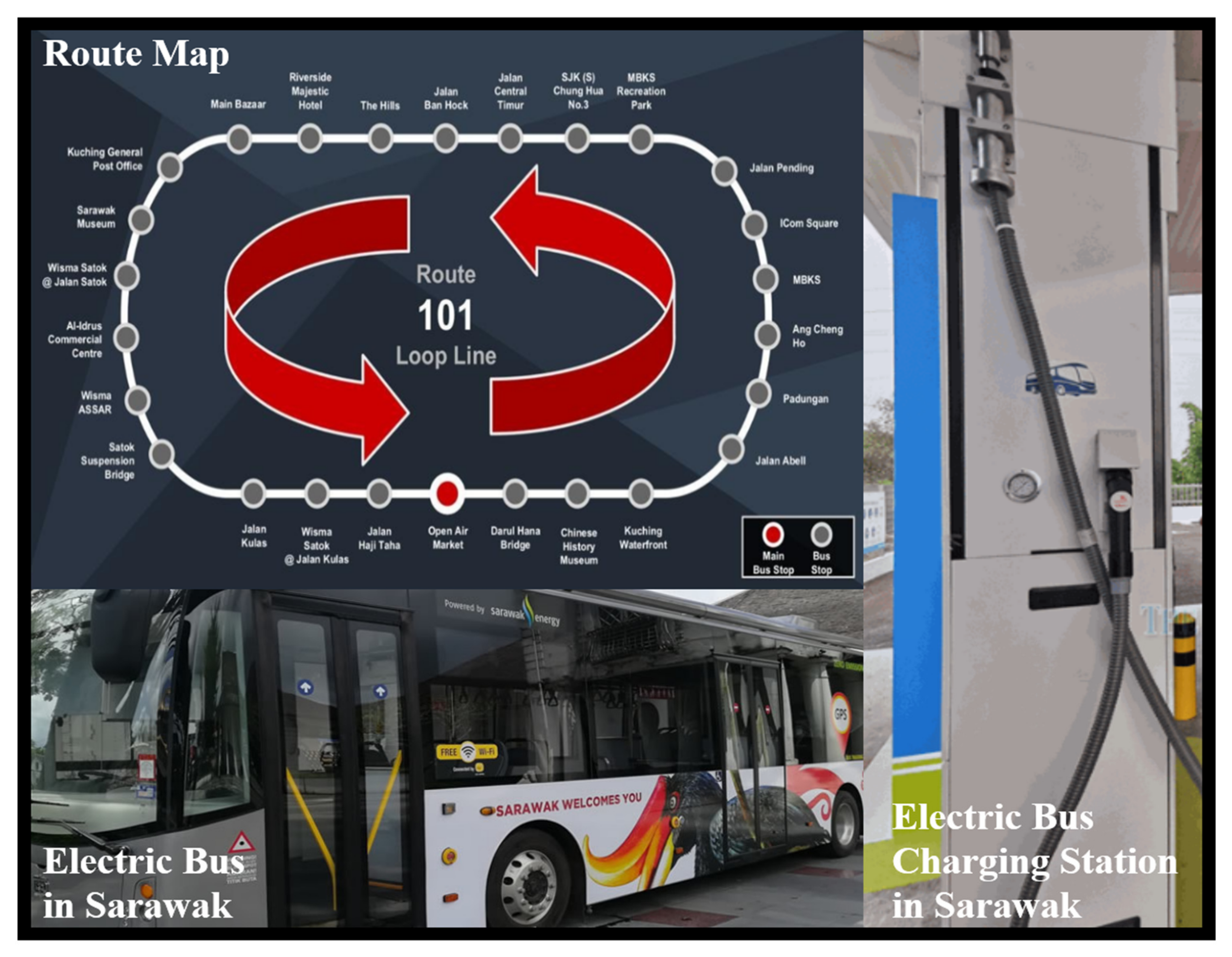
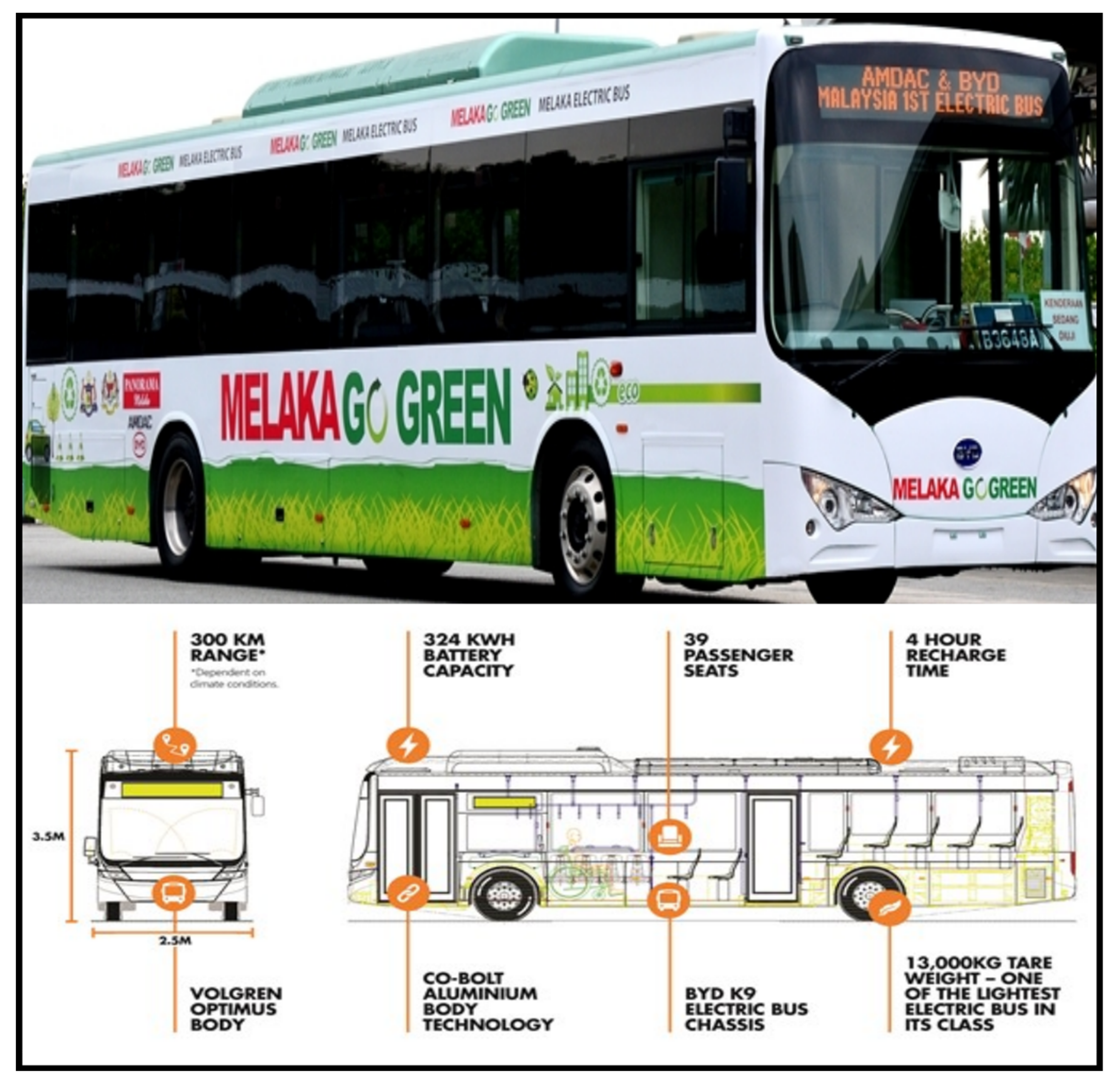
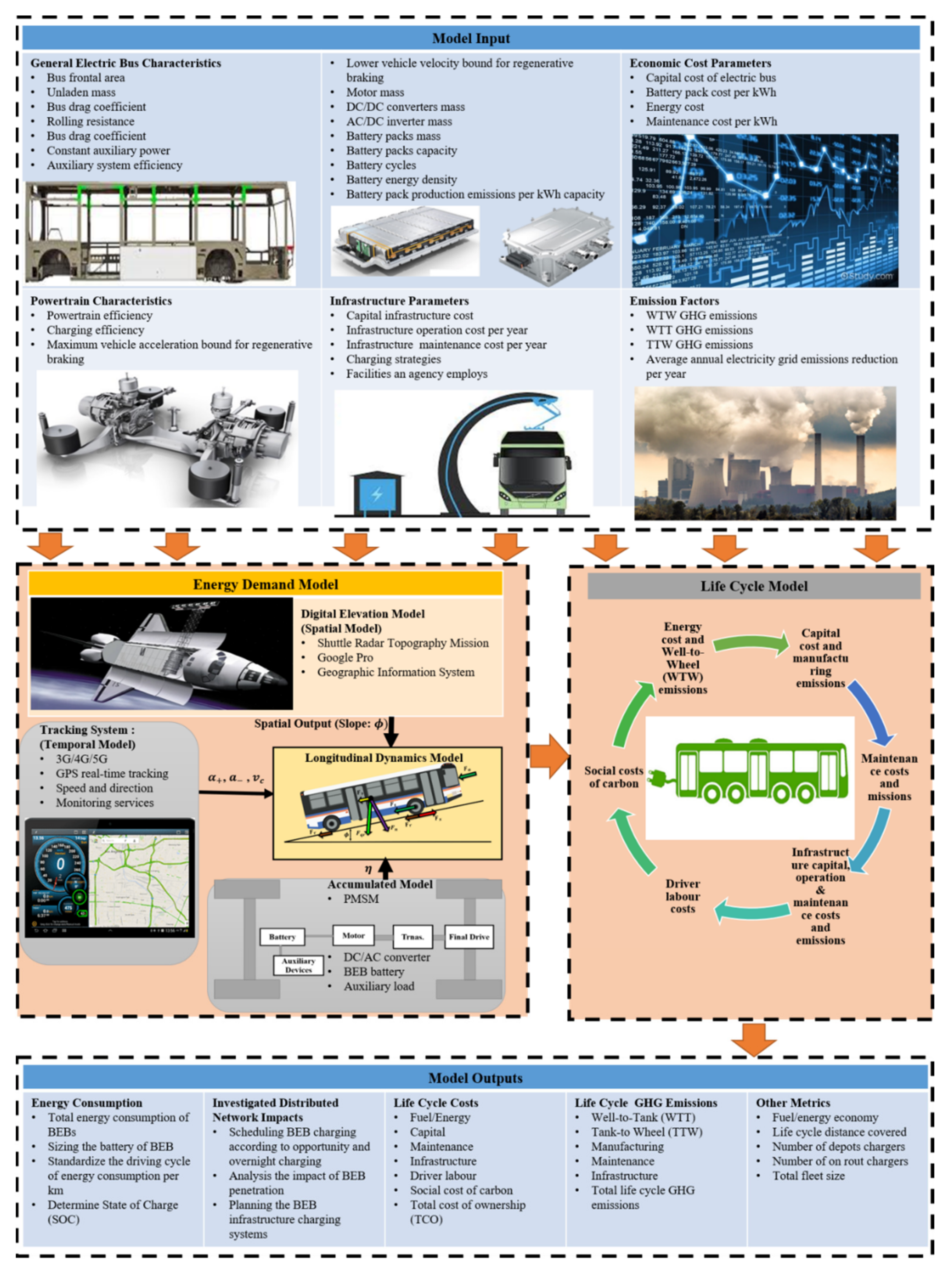

| Stage | City | Policy/Target | Implementation | |||||
|---|---|---|---|---|---|---|---|---|
| Industrial Discussions | Formal Discussions | Policy Enacted | Preliminary Test | Structured Pilot | Multi-Route Operation | Mass Route Operation | ||
| 0 | Addis Ababa, Ethiopiaa | |||||||
| 1 | Ahmedabad, Indiab | |||||||
| 1 | Quito, Ecuadorc | |||||||
| 1 | Mexico City, Mexicod | |||||||
| 1 | Cope Town, South Africae | |||||||
| 1 | Bangalore, Indiaf | |||||||
| 2 | Belo Horizonte, Brazilg | |||||||
| 2 | Bogotá, Colombiah | |||||||
| 2 | Singapore, Singaporei | |||||||
| 2 | Putrajaya, Malaysiaj | |||||||
| 2 | Madrid, Spaink | |||||||
| 2 | Philadelphia, United Satesl | |||||||
| 2 | Manali, Indiam | |||||||
| 3 | Santiago, Chilen | |||||||
| 4 | Shenzhen, China0 | |||||||
| Parameter | Value | Unit |
|---|---|---|
| Weight of the bus | 12,000 | kg |
| Load for each passenger | 75 | kg |
| Frontal area of the vehicle (A) | 7.5 | m2 |
| Drag coefficient of the vehicle (Cd) | 0.6 | - |
| Air density ( | 1.2 | - |
| Rolling resistance (Crr) | 0.01 | - |
| Acceleration because of thr gravity (g) | 9.81 |
| Test | Description |
|---|---|
| Bus Endurance Tester (BET) | The bus performance is tested by using BET to determine the system working under sustained use. |
| Anti-Lock Braking System (ABS) | To examine the function of the ABS system. |
| Finite Element Analysis (FEA) | FEA has been used to verify the functionality of the battery. |
| Charging Test | To present the correlation between both temperatures rise and charging rate. |
| Bus Dimensions | To determine the maximum height and width of the body. |
| Electronically Controlled Air Suspension (ECAS) | To prove that ECAS height modifications are correct and that the kneeling function operates without fail. |
| Acceleration test | Calculate the time it takes to accelerate from 0 to 20 km/h, 0 to 50 km/h, and 0 to 60 km/h. |
| Feature List | Description |
|---|---|
| Body type |
|
| Heating and Cooling | Thermo king X1000-E electric air conditioner |
| Exterior Paneling | One-piece side sheet all-composite fire-retardant fiberglass |
| Battery |
|
| BMS |
|
| Supervisory controller systems | The modular supervisory controller system architecture includes:
|
| Rear axle | ZF AVE 132 full electric axle with 4 airbag suspensions, 11,000 kg rating. |
| Front axle | ZF RL 85 is a low-floor axle with dual airbag suspension rated at 7000 kh. |
| Suspension | WabcoEcas controlled |
| Braking system | Wabco system incorporating ABS. |
| Steering gear | ZF 8089 Servacom |
| Tires and wheels | Three satin-finished and four durable alloy rims with 270/70 low profile tires are included. |
| Electrical system (low voltage) | 24 V (2 × 12 batteries) DC system for ancillary chassis functions, including lights, displays, and sensors. |
| Safety systems | Safety system control redundancy, including emergency stop, ISO 26262, and SAE J1673 J1654 |
Publisher’s Note: MDPI stays neutral with regard to jurisdictional claims in published maps and institutional affiliations. |
© 2021 by the authors. Licensee MDPI, Basel, Switzerland. This article is an open access article distributed under the terms and conditions of the Creative Commons Attribution (CC BY) license (https://creativecommons.org/licenses/by/4.0/).
Share and Cite
Al-Ogaili, A.S.; Al-Shetwi, A.Q.; Sudhakar Babu, T.; Hoon, Y.; Abdullah, M.A.; Alhasan, A.; Al-Sharaa, A. Electric Buses in Malaysia: Policies, Innovations, Technologies and Life Cycle Evaluations. Sustainability 2021, 13, 11577. https://doi.org/10.3390/su132111577
Al-Ogaili AS, Al-Shetwi AQ, Sudhakar Babu T, Hoon Y, Abdullah MA, Alhasan A, Al-Sharaa A. Electric Buses in Malaysia: Policies, Innovations, Technologies and Life Cycle Evaluations. Sustainability. 2021; 13(21):11577. https://doi.org/10.3390/su132111577
Chicago/Turabian StyleAl-Ogaili, Ali Saadon, Ali Q. Al-Shetwi, Thanikanti Sudhakar Babu, Yap Hoon, Majid A. Abdullah, Ameer Alhasan, and Ammar Al-Sharaa. 2021. "Electric Buses in Malaysia: Policies, Innovations, Technologies and Life Cycle Evaluations" Sustainability 13, no. 21: 11577. https://doi.org/10.3390/su132111577
APA StyleAl-Ogaili, A. S., Al-Shetwi, A. Q., Sudhakar Babu, T., Hoon, Y., Abdullah, M. A., Alhasan, A., & Al-Sharaa, A. (2021). Electric Buses in Malaysia: Policies, Innovations, Technologies and Life Cycle Evaluations. Sustainability, 13(21), 11577. https://doi.org/10.3390/su132111577









